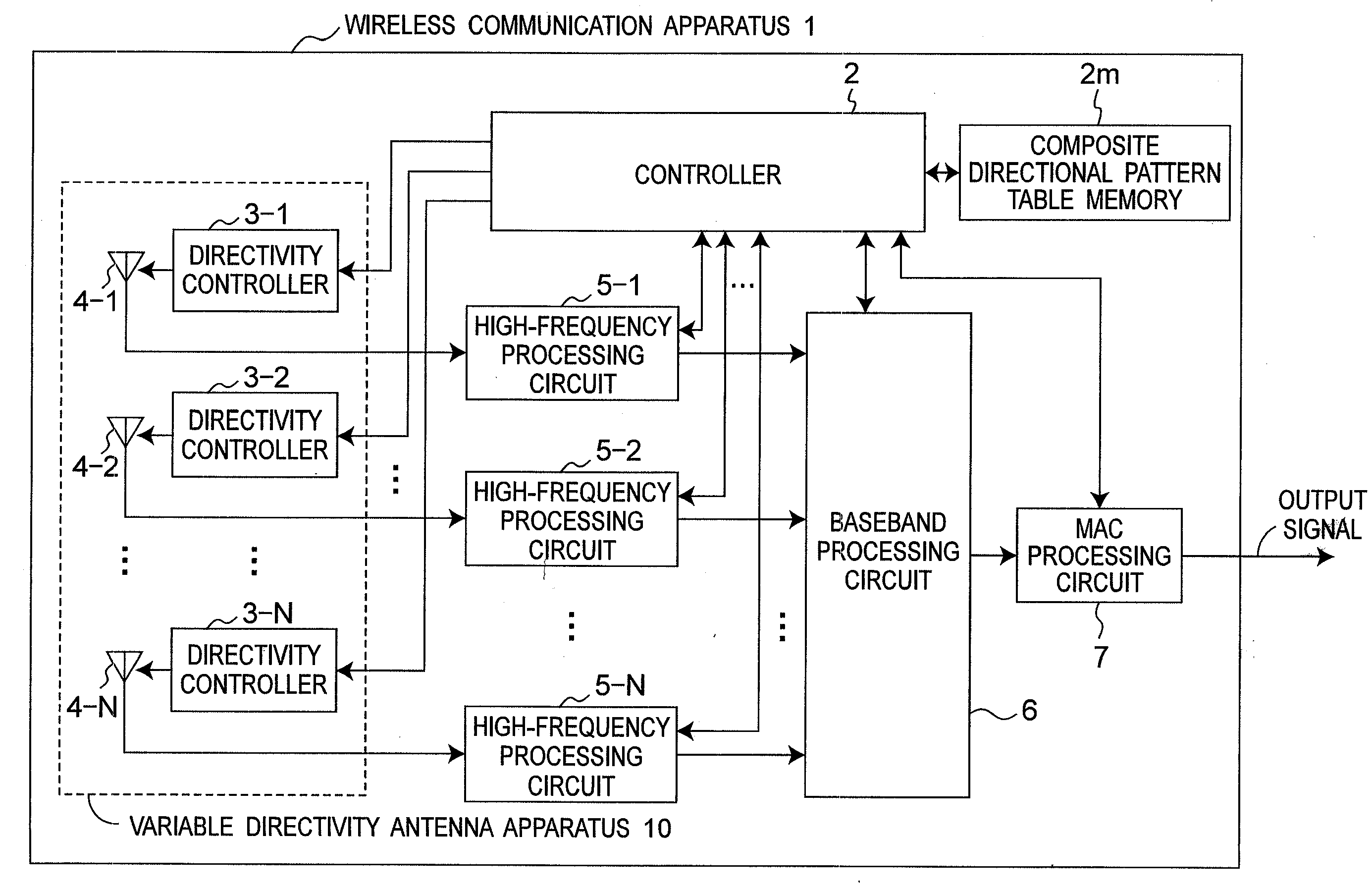Wireless communication apparatus for changing directional pattern of variable directivity antenna according to variations in radio wave propagation enviroment
a technology of variable directivity and wireless communication, applied in the direction of transmission, transmission monitoring, modulation, etc., can solve the problem that the wireless communication apparatus sometimes fails to correctly transmit data, and achieve the effect of higher speed
- Summary
- Abstract
- Description
- Claims
- Application Information
AI Technical Summary
Benefits of technology
Problems solved by technology
Method used
Image
Examples
first preferred embodiment
[0040]FIG. 1 is a block diagram showing a configuration of a wireless communication apparatus 1 according to the first preferred embodiment of the present invention. In the present preferred embodiment, a composite directional pattern table memory 2m stores therein composite directional pattern classification information of a variable directivity antenna apparatus 10 in a form of a table including the composite directional pattern classification information. FIG. 2 is a chart showing one example of a composite directional pattern table stored in the composite directional pattern table memory 2m of FIG. 1. In addition, FIG. 3 is a chart showing one example of composite directional patterns Pa to Pf of the composite directional pattern table of FIG. 2. Further, FIG. 4 is a flow chart showing a directional pattern control process executed by a controller 2 of FIG. 1, and FIG. 5 to FIG. 7 are flow charts showing a composite directional pattern group selecting process S2 of FIG. 4, a com...
second modified preferred embodiment
of First Preferred Embodiment
[0077]FIG. 9 is a flow chart showing a composite directional pattern selecting process S4B according to the second modified preferred embodiment of the first preferred embodiment of the present invention. As compared with the first preferred embodiment, the process of the second modified preferred embodiment is obtained by replacing the composite directional pattern selecting process S4 (FIG. 6) executed by the controller 2 of FIG. 1 with the composite directional pattern selecting process S4B.
[0078]Referring to FIG. 9, first of all, the processes of steps S31 to S40 are performed in a manner similar to that of the composite directional pattern selecting process S4 of FIG. 6. Then, subsequent to step S40, a composite directional pattern candidate having the smallest average value of the PER is selected at step S49, one is substituted into the flag IF representing whether or not the composite directional pattern has been able to be selected at step S44, a...
third modified preferred embodiment
of First Preferred Embodiment
[0080]FIG. 10 is a flow chart showing a composite directional pattern selecting process S4C according to the third modified preferred embodiment of the first preferred embodiment of the present invention. As compared with the second modified embodiment, the process of the third modified preferred embodiment is obtained by replacing the composite directional pattern selecting process S4B (FIG. 9) executed by the controller 2 of FIG. 1 with the composite directional pattern selecting process S4C.
[0081]Referring to FIG. 10, first of all, a first candidate is selected from among the composite directional pattern candidates at step S32 in a manner similar to that of the composite directional pattern selecting process S4A (FIG. 8) of the first modified preferred embodiment, and the respective directional patterns of the variable directivity antenna elements 4-1 to 4-N are controlled so that the variable directivity antenna apparatus 10 forms the selected compo...
PUM
 Login to View More
Login to View More Abstract
Description
Claims
Application Information
 Login to View More
Login to View More - R&D
- Intellectual Property
- Life Sciences
- Materials
- Tech Scout
- Unparalleled Data Quality
- Higher Quality Content
- 60% Fewer Hallucinations
Browse by: Latest US Patents, China's latest patents, Technical Efficacy Thesaurus, Application Domain, Technology Topic, Popular Technical Reports.
© 2025 PatSnap. All rights reserved.Legal|Privacy policy|Modern Slavery Act Transparency Statement|Sitemap|About US| Contact US: help@patsnap.com



